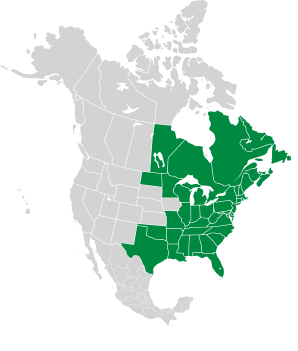Pogonia ophioglossoides (L.) Ker Gawl. var. brachypogon Fernald

|
Pogonia ophioglossoides (L.) Ker Gawl. Rose pogonia, snakemouth orchid
Rose pogonia is a perennial orchid, native to central and eastern North America. It is found in bogs, fens, prairies, meadows, woodlands, swamps, and along river or pond edges. It is rare but not endangered over much of its range. Plants: 1½-28″ (4-70 cm) tall, occurring sometimes in colonies. Leaves: A single clasping leaf appears midway up the stem. It is 1½-4″ (3.8-10 cm) × ¾″ (1.9 cm). Flowers: One, rarely two, or very rarely three flowers top each stalk. Flowers are pink, or rarely white. The labellum, or lip, has jagged (lacerate) edges and a “beard” comprised of several rows of dark pink, yellow, or purple hairs. It is ⅜-⅞″ (1.2-2.5 cm) long. Sepals are ½-⅞″ (1.4-2.3 cm) long. There is an erect upper sepal, and two petals forming a hood. Flowers appear from June to August. Fruits: An erect capsule up to 1″ (2.5 cm) long. These similar species are found in similar habitats: |
6/20/2021 · Heath, Cathance River Nature Preserve, Highland Green, Topsham, Maine · ≈ 6 × 4″ (15 × 10 cm) 6/20/2021 · Heath, Cathance River Nature Preserve, Highland Green, Topsham, Maine |
||||||||||||||||||||||||||||
|
| |||||||||||||||||||||||||||||
Arethusa bulbosa |
You are here Pogonia ophioglossoides |
||||||||||||||||||||||||||||
|---|---|---|---|---|---|---|---|---|---|---|---|---|---|---|---|---|---|---|---|---|---|---|---|---|---|---|---|---|---|
| Common Name |  |
 |
|||||||||||||||||||||||||||
| Plant | Inconspicuous unless flowering, but flowers are showy and unique. At less than 1′ (40 cm) tall, smaller than similar orchids. And the labellum, or lip, is lowermost, vs. uppermost on grass pinks. | 1½-28″ (4-70 cm) tall, occurring sometimes in colonies. | |||||||||||||||||||||||||||
| Flowers | Each stem is 4-16″ (10-40 cm) long, and tipped by a single flower, rarely two. Each flower has three sepals on top, like rabbit ears, and two petals that form a hood. The sepals are ¾-2″ (2-5.5 cm) long. A colorful lower lip—the labellum—is ¾-1¼″ (1.9-3.5 cm) long, and white, with a yellow middle region and pink speckles, and some bristles in the center. Sepals and petals are pink to red, and rarely, white. Flowers appear from May to as late as mid-July, depending upon region. | One, rarely two, or very rarely three flowers top each stalk. Flowers are pink, or rarely white. The labellum, or lip, has jagged (lacerate) edges and a “beard” comprised of several rows of dark pink, yellow, or purple hairs. It is ⅜-⅞″ (1.2-2.5 cm) long. Sepals are ½-⅞″ (1.4-2.3 cm) long. There is an erect upper sepal, and two petals forming a hood. Flowers appear from June to August. | |||||||||||||||||||||||||||
| Leaves | A single, basal, grasslike leaf, 1½-8″ (4-20 cm) × ⅛-⅜″ (3-12 mm), typically develops after flowering. | A single clasping leaf appears midway up the stem. It is 1½-4″ (3.8-10 cm) × ¾″ (1.9 cm). | |||||||||||||||||||||||||||
| Fruit | An erect capsule, ¾-1¼″ (1.9-3.2 cm) long. | An erect capsule up to 1″ (2.5 cm) long. | |||||||||||||||||||||||||||
| Range/ Zones |
|
|
|||||||||||||||||||||||||||
| Habitats | Bogs, meadows, fens, and fields, and the edges of swamps and other wetlands. | Bogs, fens, prairies, meadows, woodlands, swamps, and along river or pond edges. | |||||||||||||||||||||||||||
| Type | Wild | Wild | |||||||||||||||||||||||||||
| Occurrence | Rare | Rare | |||||||||||||||||||||||||||
Online References:
Goorchids.northamericanorchidcenter.org
6/19/2021 · Long Reach Preserve, Harpswell, Maine 
6/20/2021 · Heath, Cathance River Nature Preserve, Highland Green, Topsham, Maine · ≈ 5 × 8″ (13 × 20 cm) 
6/20/2021 · Heath, Cathance River Nature Preserve, Highland Green, Topsham, Maine · ≈ 8 × 5″ (20 × 13 cm) 
6/20/2021 · Heath, Cathance River Nature Preserve, Highland Green, Topsham, Maine · ≈ 4 × 6″ (10 × 15 cm) 
Pogonia ophioglossoides (L.) Ker Gawl. var. brachypogon Fernald
Pogonia ophioglossoides description by Thomas H. Kent, last updated 17 Oct 2023.
© FloraFinder.org. All rights reserved.
6/20/2021 · Heath, Cathance River Nature Preserve, Highland Green, Topsham, Maine · ≈ 4½ × 3″ (11 × 7.9 cm) 
6/18/2021 · Long Reach Preserve, Harpswell, Maine · By Priscilla Seimer 
6/19/2021 · Long Reach Preserve, Harpswell, Maine 
6/20/2021 · Heath, Cathance River Nature Preserve, Highland Green, Topsham, Maine 
Preserved by the Frenchman Bay Conservancy · 6/27/2011 · Hancock County, Maine · By Susan Cole Kelly 
Range: Zones 3-8:
